RBSE Solutions for Class 8 Maths Chapter 3 Understanding Quadrilaterals Ex 3.3
Rajasthan Board RBSE Solutions for Class 8 Maths Chapter 3 Understanding Quadrilaterals Ex 3.3 Textbook Exercise Questions and Answers.
Rajasthan Board RBSE Solutions for Class 8 Maths in Hindi Medium & English Medium are part of RBSE Solutions for Class 8. Students can also read RBSE Class 8 Maths Important Questions for exam preparation. Students can also go through RBSE Class 8 Maths Notes to understand and remember the concepts easily. Practicing the class 8 maths chapter 6 try these solutions will help students analyse their level of preparation.
RBSE Class 8 Maths Solutions Chapter 3 Understanding Quadrilaterals Ex 3.3
Question 1.
Given a parallelogram ABCD. Complete each statement along with the definition or property used.
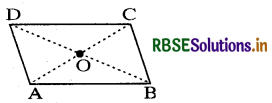
(i) AD = .........
(ii) ∠DCB = ............
(iii) OC = ..........
(iv) m∠DAB + m∠CDA = ............
Answer:
(i) AD = BC, ∵ We know that in a parallelogram, opposite sides are equal.
(ii) ∠DCB = ∠DAB, ∵ We know that in a parallelogram, opposite angles are equal.
(iii) OC = OA, v∵ We know that the diagonals of a parallelogram bisect each other.
(iv) m∠DAB + m∠CDA = 180°, ∵ We know that in a parallelogram, the sum of any two adjacent angles is 180°.

Question 2.
Consider the following parallelograms. Find the values of the unknowns x, y, z.
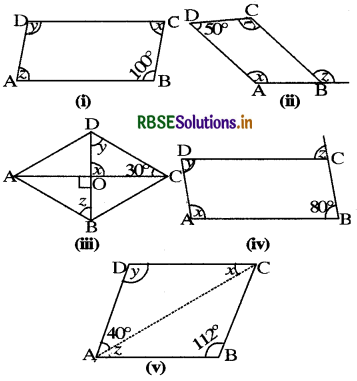
Answer:
(i) We know that the sum of any two adjacent angles of a parallelogram is 180°, therefore,
x + 100°= 180°
or x = 180° - 100° = 80°
x + y = 180°
or y = 180° - x = 180° - 80° = 100°
y + z = 180°
or z = 180°- y = 180°- 100° = 80°
Hence, x = 80°, y = 100° and z = 80°
(ii) According to question ABCD is a parallelogram, therefore, AB || DC and AD || BC Now, AB || DC and transversal BC intersects them.
∴ z = y [∵ Alternate angles are equal] and, AD || BC and transversal AB intersects them.
∴ z = x [∵ Corresponding angles are equal]
⇒ x = y = z
We know that the sum of any two consecutive angles of a parallelogram is 180°, therefore,
y + 50°= 180° ⇒ y = 180° - 50° = 130°
Thus x= y = z = 130°
(iii) From the figure, it is clear that x = 90°
[∵ Vertically opp. angles are equal]
In ∆DOC, we have
∠DOC + ∠OCD + ∠CDO = 180°
[Angle sum property of triangle]
or x + 30° + y = 180°
or 90° + 30° + y= 180°
or y = 180° - 120° = 60°
In a parallelogram ABCD, AB || DC. Also, the transversal BD intersects them.
∴ z = y .
[∵ Alternate angles are equal]
⇒ z - 60° [∵ y = 60°]
∴ x = 90°, y = 60° and z = 60°
(iv) We know that the sum of any two adjacent angles of a parallelogram is 180°, therefore,
∠A + ∠B = 180° or x + 80° = 180°
or x = 180° - 80° = 100°
∠A + ∠D = 180° or x + y = 180°
or y = 180° - x = 180° - 100° = 80°
∠D + ∠C = 180°
or y + ∠C = 180°
or ∠C = 180° - y = 180° - 80° = 100°
Also, ∠C + z = 180° [Linear pair]
or z = 180° - ∠C = 180° - 100° = 80°
Hence, x = 100°, y = 80°, z = 80°
(v) We know that opposite angles are equal in a parallelogram, therefore,
y = 112°
In ∆ACD, by angle sum property
or x + y + 40°= 180°
or x + 112° + 40°= 180°
or x+ 152°= 180°
or x = 180° - 152° = 28°
In parallelogram ABCD, AB || DC and also transversal AC intersets them.
∴ z = x
(∵ Alternate angles are equal)
or z = 28°
Hence, x = 28°, y = 112° and z = 28°

Question 3.
Can a quadrilateral ABCD be a parallelogram if
(i) ∠D + ∠B = 180°?
(ii) AB = DC = 8 cm, AD = 4 cm and BC = 4.4 cm?
(iii) ∠A = 70° and ∠C = 65°?
Answer:
(i) If in a quadrilateral ABCD, ∠D + ∠B = 180°, then it is not necessary that ABCD is a parallelogram.
(ii) Since AD ≠ BC, i.e., the opposite sides are unequal, so ABCD is not a parallelogram.
(iii) Since ∠A ≠ ∠C, i.e., the opposite angles are unequal, so ABCD is not a parallelogram.
Question 4.
Draw a rough figure of a quadrilateral that is not a parallelogram but has exactly two opposite angles of equal measure.
Ans:
A rough figure of a quadrilateral ABCD that is not a parallelogram has been drawn with exactly two opposite angles of equal measure such that ∠A = ∠C which is a kite as ah example.
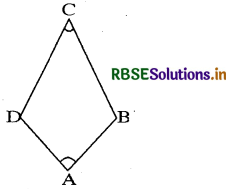
Question 5.
The measures of two adjacent angles of a parallelogram are in the ratio 3 : 2. Find the measure of each of the angles of the parallelogram.
Answer:
Let two adjacent angles A and B of parallelogram ABCD be 3x and 2x respectively.
∴ ∠A + ∠B = 180°
or 3x + 2x = 180°
or 5x = 180°
or x = \(\frac{180^{\circ}}{5}\) = 36°
∴ ∠A = 3 × 36°= 108°
and ∠B = 2 × 36° = 72°
Since the opposite angles are equal in a parallelogram. .
Therefore, ∠C = ∠A = 108° and ∠D = ∠B = 72°
∴ ∠A = 108°, ∠B = 72°, ∠C = 108° and ∠D = 72°
Question 6.
Two adjacent angles of a parallelogram have equal measure. Find the measure of each of the angles of the parallelogram.
Answer:
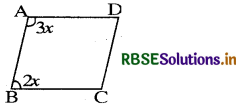
Let x be the measure of two adjacent angles A and B.
We know that the adjacent angles of a parallelogram are supplementary.
∴ ∠P = 90° and∠Q = 90°
We know that the opposite angles are equal in a parallelogram.
∴ ∠P + ∠Q = 180°
or x + x = 180°
or 2x = 180°
∴ ∠P = ∠Q = ∠R = ∠S = 90°

Question 7.
The adjacent figure HOPE is a parallelogram. Find the angle measures x, y and z. State the properties you use to find them.
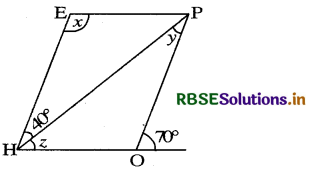
Answer:
Since HOPE is a parallelogram, therefore, HE || OP and HO || EP Now, HE || OP and transversal HO intersect them.
∴ ∠EHO = ∠POX
[∵ Alternate angles are equal]
or 40° + z = 70°
or z = 70° - 40° = 30°
Again, HE || OP and transversal HP intersects them.
∴ ∠OPH = ∠EHP
[∵ Alternate angles are equal]
or y = 40°
Since opposite angles are equal in a parallelogram.
∴ ∠HEP = ∠HOP
or x = 180° - ∠POX
= 180° - 70° = 110°
∴ x = 110°, y = 40° and z = 30°
Question 8.
The following figures GUNS and RUNS are parallelograms. Find x and y. (Lengths are in cm)
(i)
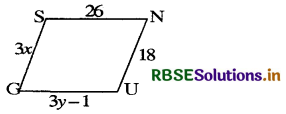
Answer:
Since GUNS is a parallelogram, therefore, its opposite sides are equal.
i.e., GS = UN and GU = SN
or 3x = 18, ⇒ x = 6
and 3y - 1 = 26
or 3y = 26 + 1 = 27
or y = 9
∴ x = 6 cm and y = 9 cm
(ii)
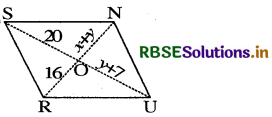
Answer:
Diagonals of a parallelogram bisect each other, therefore,
OR = ON i.e. 16 = x + y .......... (1)
and OU = OS i.e. y + 7 = 20 ........... (2)
From (2), y = 20 - 7 = 13 cm
putting y = 13 in (1), we get
16 = x + 13
or x = 16 - 13 = 3 cm
Hence x = 3 cm and y = 13 cm

Question 9.

In the above figure both RISK, and CLUE are parallelograms. Find the value of x.
Answer:
In the parallelogram RISK,
∠RIS = ∠RKS = 120°
[∵ opposite angles are equal]
or ∠OIC = 180° - ZRIS [Linear pair]
or ∠OIC = 180° - 120° = 60°
In the parallelogram CLUE, CE || LU and a transversal ICL intersects them.
∴ ∠ICO = ∠CLU
[∵ corresponding angels are equal]
or ∠ICO = 70°
In ∆OIC, by angle sum property, we have
∠IOC + ∠OIC + ∠IOC = 180°
or ∠IOC + 60° + 70° = 180°
or ∠IOC = 180° - 60° - 70°
= 50°
∴ x = ∠IOC = 50° Ans.
[∵ Vertically opposite angles are equal]
Question 10.
Explain how this figure is a trapezium. Which of its two sides are parallel?
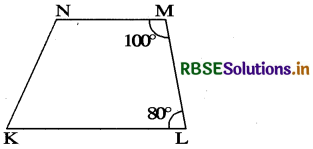
Answer:
Since ∠KLM + ∠NML = 180°
i.e., the pair of consecutive interior angles are supplementary. Therefore, KL || NM and so KLMN is a trapezium.
Question 11.
Find m∠C in Fig. if \(\overline{\mathbf{A B}} || \overline{\mathbf{D C}}\).
Answer:
Since AB || CD and transversal BC intersects them.
∴ ∠B + ∠C = 180°
[∵ Sum of interior angles is 180°]
or 120° + ∠C = 180°
or ∠C = 180° - 120°
= 60°
∴ m∠C = 60°

Question 12.
Find the S measure of ∠P and ∠S if \(\overline{\mathbf{S P}}||\overline{\mathbf{R Q}}\) in Figure. (If you find m∠R, is there more than one method to find m∠P?)
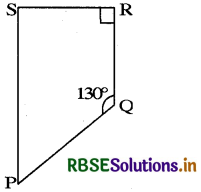
Answer:
Since SP || RQ and PQ is a transversal intersecting them at P P and Q.
∴ ∠P + Q= 180°
[∵ Sum of interior angles is 180°]
or ∠P + 130° =180°
or ∠P= 180° - 130° = 50°
Again, SP || RQ and SR is a transversal intersecting them at S and R.
∴ ∠S + ∠R = 180°
[∵ Sum of interior angles is 180°]
or ∠S + 90°= 180°
or ∠S = 180° - 90° = 90°
Yes, we can find m∠P in an another way as under
m∠P + m∠Q + m∠R + m∠S = 360° (angle sum property)
or m∠P + 130° + 90° + 90°= 360°
or m∠P = 360° - 310°
= 50°

- RBSE Solutions for Class 8 Maths Chapter 11 क्षेत्रमिति Ex 11.3
- RBSE Solutions for Class 8 Maths Chapter 2 एक चर वाले रैखिक समीकरण Ex 2.4
- RBSE Solutions for Class 8 Maths Chapter 6 Square and Square Roots Intext Questions
- RBSE Solutions for Class 8 Maths Chapter 11 क्षेत्रमिति Ex 11.2
- RBSE Solutions for Class 8 Maths Chapter 6 वर्ग और वर्गमूल Ex 6.2
- RBSE Solutions for Class 8 Maths Chapter 3 चतुर्भुजों को समझना Ex 3.2
- RBSE Solutions for Class 8 Maths Chapter 5 Data Handling Intext Questions
- RBSE Solutions for Class 8 Maths Chapter 11 Mensuration Intext Questions
- RBSE Solutions for Class 8 Maths Chapter 2 एक चर वाले रैखिक समीकरण Ex 2.5
- RBSE Solutions for Class 8 Maths Chapter 8 Comparing Quantities Intext Questions
- RBSE Solutions for Class 8 Maths Chapter 7 घन और घनमूल Ex 7.2